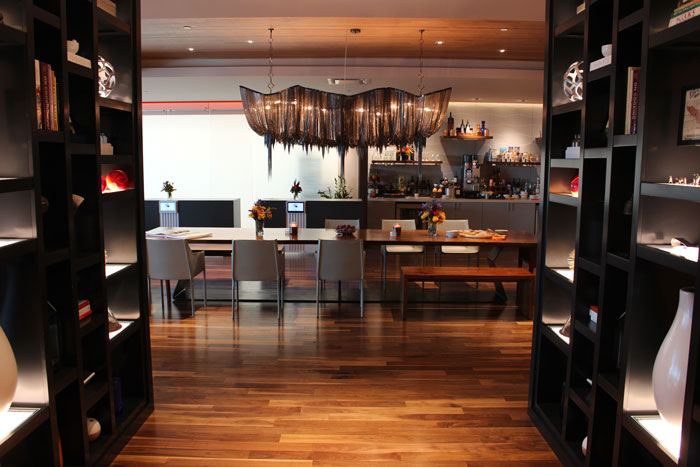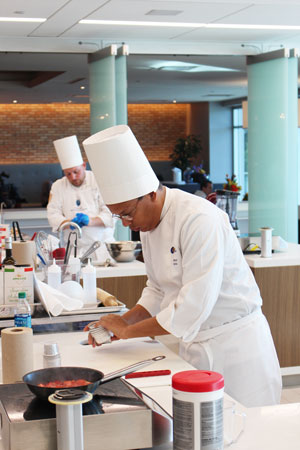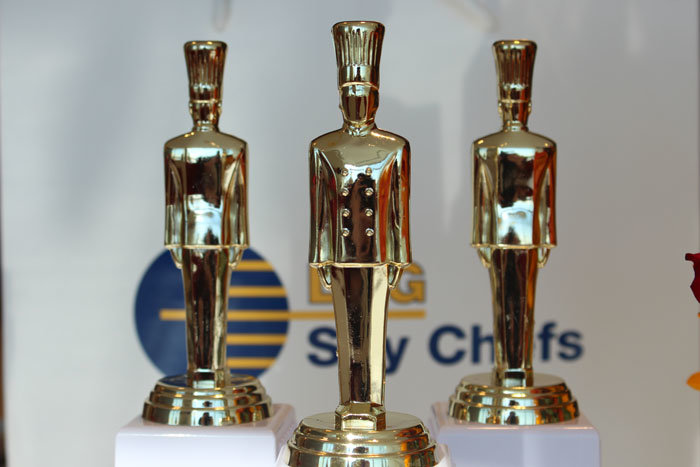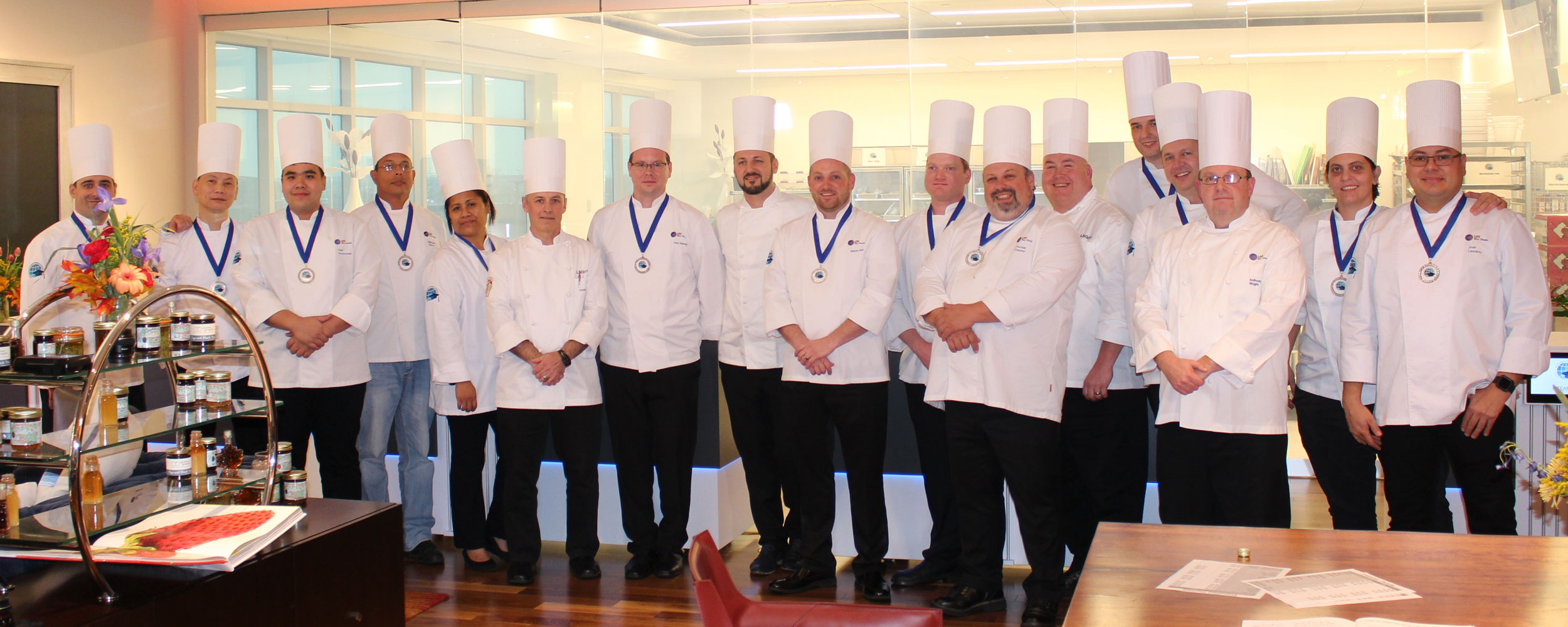LSG Group: Culinary Academy Final in Chicago
In Chicago, the 13 participants of the first Global Culinary Excellence Academy completed the final exams of the jurors.
From 13 to 15 November 2018, the 13 finalists of the first Global Culinary Excellence Academy (GCEA) met in Chicago. There, three challenging examination days awaited the first future graduates of the academy (link to articles DE and EN). Spoiler alert: Everyone passed, three with outstanding results.
But let’s go back to the beginning. It’s a freezing cold Tuesday morning in Des Plaines, a suburb of the metropolitan Chicago. At the neighboring O’Hare Airport, one plane takes off after another with a roar into the bright blue sky, before slowly disappearing in the light of the morning sun. In front of the LSG Sky Chefs entrance, the 13 candidates, still slightly tired from their trip, group together. Even the fully glazed, light-flooded foyer sets the tone: The stage for the first GCEA finale is gorgeous and couldn’t have been chosen better.
Welcome to Chicago: The ‘wow’ moment

Once inside, Anthony “Chef Tony” Wright (LSG Sky Chefs, North America) welcomes his guests with a bright smile and a good mood. The level of confidence in the room increases and the initial nerves disappear. The 11 male chefs and two female chefs from ten countries arrived to deliver culinary excellence over the following three days and to convince the three jurors Bill Gillen (LSG Sky Chefs, North America), Stefan Grammel (LSG Group) and Daniel Klein (LSG Sky Chefs, North America). But first of all, the facilities designed for our customers that impress our students too. The spacious room in which they stand is divided into two sections. On one side of a wall of rows of sliding glass doors that change to milky or transparent at the touch of a button, there is a true feel-good landscape of comfortable leather sofas, beautiful wooden furniture and countless lovingly arranged objects. If you take a closer look, you will discover various references to Chicago – such as the colors of the great fire or the local honeycomb pattern. But the candidates don’t have a thought for this.
They quickly follow Chef Tony into the other side of the room, the bright and sparkling white presentation kitchen with several separate cooking zones. Here, porcelain and tableware pile up and the food awaits its culinary destiny in several fully-stocked refrigerators. The culinary professionals will demonstrate their practical skills in this kitchen. The cooking utensils are just as standardized as the goods basket. That way, every participant has the same chances and possibilities. After a stimulating discovery tour, the 13 participants are allowed to carry out their preliminary steps. Accordingly, knives work their way through vegetables as quick as lightning, the food is pre-portioned and with every moment that passes, it becomes clear: It gets serious! The professionals want to deliver.
Day 1: The theory
But before any of their creative action can take place, they must fulfill their duty: The group of professional chefs must first take the written examination on Wednesday morning. Over the past two GCEA years, the candidates have dealt with a wide variety of specialist topics from the airline catering and culinary worlds. Now they have to prove that they have really understood and internalized what they have learned.
In the airline catering business, the focus is on understanding general nutrition issues, allergies and allergens, dietary restrictions and special dishes for passengers on board an aircraft. However, management skills must also be proven in the written test. The same applies to material and commodity science, culinary mathematics and the economics of nutrition. Additionally, the topics of hygiene, quality, standards and logistics – especially important in our industry – are also in the spotlight. And not to forget, a solid basic understanding of gastronomy, hospitality and the aviation industry.
After a few hours, the first participants leave the examination room one by one and the relaxed faces reveal their impressions: The global eLearning platform, the digitally provided learning content and the international learning network have paid off. They don’t know it yet, but all 13 participants of the Global Culinary Excellence Academy will jump this hurdle and pass the written exam.
Day 2: The practice
At 7.30 am the next morning, the 13 highly motivated talents enter the shuttle bus to the facility, with the weather at its best. While the kitchen fills with life and the first utensils and ingredients are taken from the shelves and refrigerators, daylight floods the room and makes the colors of the ingredients shine just as brightly as the blossom-white aprons.
 Under the strict eyes of the three jurors, the first of the four teams walks to the workstations provided for them. Each team has been assigned its own challenge, which includes a specific theme (e.g. Food to Go) and a specific target group (e.g. millennials). In addition, at least one component of the menu consisting of a starter, main course and dessert must be a special dish. Each team member executes the task in his or her own way. You can quickly imagine how colorful the combination of meals and forms of presentation will be at the end. It is washed, cut, cooked, roasted, baked and sweated. The latter may especially be the case when the jurors begin circling the room, approaching the students and asking questions, or simply observing while taking notes.
Under the strict eyes of the three jurors, the first of the four teams walks to the workstations provided for them. Each team has been assigned its own challenge, which includes a specific theme (e.g. Food to Go) and a specific target group (e.g. millennials). In addition, at least one component of the menu consisting of a starter, main course and dessert must be a special dish. Each team member executes the task in his or her own way. You can quickly imagine how colorful the combination of meals and forms of presentation will be at the end. It is washed, cut, cooked, roasted, baked and sweated. The latter may especially be the case when the jurors begin circling the room, approaching the students and asking questions, or simply observing while taking notes.
Hardly anything escapes their sharp eyes. There is tension in the air. The food safety and hygiene, organizational skills, craftsmanship, presentation and taste quality of the food are assessed. However, this is not the case today. In order to come as close as possible to the actual requirements of the airline industry, all nearly-finished meals are cooled at the end of the day and stored overnight (Cook & Chill). The following day, the dishes are first warmed up, finalized and then tasted by the jury. On this day, the culinary experts leave their workplaces without feedback. Only on the last day of the examination will they individually step in front of the three jurors and offer their menu for tasting. A calm mind and nerves of steel are now paying off.
Day 3: Final statement
The last day of the exam begins. One after another, the four teams of the previous day step up to their workplaces for the last time and put the finishing touches to their menus. Then, they take turns, appearing in front of the jurors one after another to explain their ideas. Chef Tony has now joined the triumvirate. Four forks now move towards the plates and the food has finally reached the jurors’ palate. But still, the students have to wait for feedback until all the menus of the day have been tasted and the overall score has been compiled from the theoretical and practical tests. No facial expressions or comments are revealed in advance about how the candidates performed.
And it is not only the taste and appearance of the dish that is a factor. The practical part of the examination is also about a convincing presentation. Has the chef thought conclusively about the task assigned to the group and can he or she explain their ideas convincingly? Have they included other aspects, such as dietary considerations? Does supplementary information play a role and has it been integrated in an appealing way? And how elaborate are the creations presented?
Step by step, a conference table several meters long fills up with the starters, main courses and desserts of all the graduates. And although they all had the same products available, a diverse palette of colors, tastes and concepts quickly spread across the white surface – until the last one puts his plate down. Then it turns quiet.
The moment of truth
While the exhausted participants still discuss their experiences, the jurors are already setting up in front of the glass wall in the background. Once again, it turns quiet in the room. Framed certificates and a medal await those who have passed. In addition, there are three trophies in the room, which will be given to the best performers. Juror Stefan has been tasked to deliver the results, and he gives the verdict: All of them have passed and successfully completed the Global Culinary Excellence Academy. The anxiety gives way quickly to relief and joy. Now, one after another, the jury calls the names of each participant and asks the students to join them. As each individual picks up his medal and certificate, you can feel their pride in their performance. You can clearly see it in their happy smile.

But three names have not yet been mentioned and the three trophies are still waiting for their new owners. The award is given to those who have achieved the best overall result from the written and practical examinations. Then Clinton from Dallas is called to the front, receiving the bronze award. Silver goes to his fellow US colleague Joseph, also from Dallas. The two US colleagues have truly earned their place in the top field. Only one name has not yet been mentioned and he is obviously surprised and visibly moved. Ivari from Tallinn, a tall colleague from Estonia, has worked his way to the top with his calm and disciplined nature over the past three days and received the best rating under the enthusiastic applause of his colleagues. With his menu for millennials, he has proven that he is one of the company’s most talented chefs. Congratulations, Ivari!
What the graduates who like to celebrate don’t know yet: A little later, they will all be sitting in the restaurant on the 95th floor of the Chicago Hancock Building, enjoying excellent food and drinks as well as the magnificent view of the vibrant city of Chicago and its incomparable skyline. The evening, and thus the first Global Culinary Academy, is coming to an end in the best of moods and full of pride. But the collegiality and companionship of this group that could be felt in the last few days indicates this: This story is far from over.

A big congratulations to all 13 graduates!